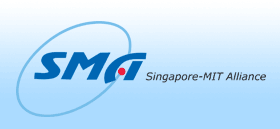| |
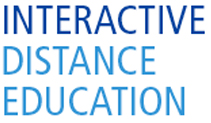
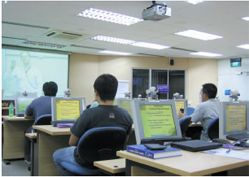 A live lecture being beamed from MIT to the NTU Smart Classroom A live lecture being beamed from MIT to the NTU Smart Classroom
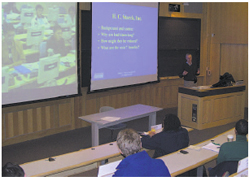 MIT Room 1-390 (Picture taken by Ms Jocelyn Sales, MIT) MIT Room 1-390 (Picture taken by Ms Jocelyn Sales, MIT)
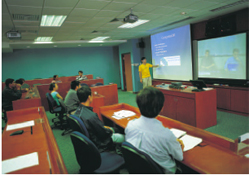 NUS SoC Conference Room (Picture taken by Ms Jocelyn Sales, MIT) NUS SoC Conference Room (Picture taken by Ms Jocelyn Sales, MIT)
|
|
|
|
Technology is the basis of today’s integrated communication,
collaboration, learning, creativity and productivity. As technology
and the forces of globalisation change the face of education, the
Singapore-MIT Alliance (SMA) continuously refines its distance
education facilities.
Combining the expertise and resources from MIT, NUS and NTU, SMA
has created an interactive distance learning environment, facilitating
dynamic exchanges between faculties and students in their intellectual
pursuit par excellence.
In partnership with faculties from the three universities, the programme
was designed to offer students full access to all forms of course delivery
in both synchronous and asynchronous forms.
Synchronous Platform
Synchronous delivery of subject curricula is achieved using video
conferencing hardware to conduct video conferencing and application
sharing over the Internet2 infrastructure.
A dual screen setup consisting of a “video screen” and “computer
screen” is available in all SMA classrooms. The “video screen”
comprises content from various cameras in the classroom including
the presenter, students, chalkboard/whiteboard and visualiser.
The “computer screen” displays all computer-based materials such as
PowerPoint slides, animations, simulations and other software used
by the faculty in the classroom.
Combining the video and computer content provides a realistic learning
environment, which enables both faculty and students from MIT, NTU
and NUS to interact without having to be present in the same location.
Asynchronous Platform
Asynchronous delivery is achieved using Stellar, MIT’s course
management system. This system was designed to provide a rich set
of features, which includes posting and reviewing of class materials,
making announcements, conducting discussions and many more. This
offers faculty and students a customised and flexible way of organising
course content.
|
|
